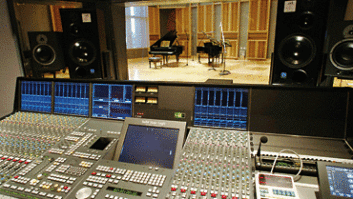As is common in tech industries, “faster” and “more” are generally top features of new products unveiled in professional audio. This is arguably most apparent within our recording interface category; today, highly portable, comprehensively featured interfaces provide all grades of I/O, native processing, low latencies and much more.
To wit, the recent NAMM Show in Anaheim, CA was the launch pad to a number of new interfaces, as the event’s mix of MI and professional audio manufacturers proves a draw for a wide swath of the marketplace, from retailers to end users. Many see (and salivate over) these products’ impressive feature sets upon announcement, yet how are their capabilities matching the majority of end-user needs?
“The rise of the ‘all-in-one’ I/O is more of a way to show more value to the end-user, rather than the end-user asking for all of the features found on these items,” offers Michael Brinker, Pro Audio Group manager, Sweetwater. “Most creative people just want to create, and having too many features can get in the way. Simplicity many times is the key to a great result. Of course, people shop, and the more features an item has, the shinier it looks. Manufacturers know this and they strive to capture their share of customers. So I guess the customers and the manufacturers somewhat influence each other in this respect.”
The appeal of better, faster connections with our DAWs’ CPUs is precisely where this narrative begins for many customers, explains Austin Waynick, Guitar Center Professional (GC Pro) account manager, Southeast Region. “A few years ago, we started to see a lot of people migrating from USB to faster connections. At the time, it was FireWire; now it’s Thunderbolt, [the latter of which] being the more popular choice for the elite prosumer or the professional engineer.”
“Universal Audio’s Apollo with multiple processing cards is probably my most popular interface these days,” shares Waynick. “[Customers] really like the Duo, more so than the Solo. They like having two cards, now four in the one UA just released. It’s a great example of a lot of processing power for under $1,000, all inside of a 2-in/2-out interface.”
As of late, hardware manufacturers have been more directly courting Pro Tools users as well as AoIP dabblers, explains Brinker. “One of the more recent trends we have noticed at Sweetwater is the addition of the DigiLink connection on many interfaces. When Avid made Pro Tools more agnostic from its hardware, other brands rushed to market with the DigiLink connection on their interfaces to take advantage of the more open platform of the industry’s leading DAW. While some companies have had other hardware in a ‘jailbreak’ fashion, the move by Avid legitimized all brands to make a Pro Tools hardware solution. The other trend in the marketplace is Audio over Ethernet, and many companies have digital snake solutions for Live Sound. While there are many formats—such as Dante, MADI, AVB, insert your favorite here—some companies have simply engineered their own. The most successful at Sweetwater would be Midas/Behringer with their Ultranet protocol. Audio over Ethernet is something that customers want, but the choices are too complicated without the consultation of a knowledgeable source.”
Interfaces touted by impressive low-latency specifications have noticeably multiplied within the marketplace. Have the creative habits of audio content creators influenced the popularity of this feature, or has the proliferation of such I/O influenced creative behaviors?
“Zero latency has become a specification that everyone is striving for,” offers Sweetwater’s Brinker. “Latency can be very frustrating and turn expensive gear into expensive paperweights. Even artists that have no recording knowledge can perceive very small amounts of latency, and that can throw off a great performance. This simple fact has had engineers scrambling to find a path to zero latency. This specification is so critical to the recording process that it is often one of the first questions we ask of a manufacturer: ‘What is your latency?’”
For Waynick, “near-zero latency” seems to be more of an increasingly given feature rather than something most of his customers are specifically looking for when purchasing comprehensive I/O units. “Today, your average Mac Book has quad-core processing, and 16 GB of RAM is the standard,” offers Waynick. “Five years ago, you were paying $10,000 for a configuration like that. It’s the same thing with the interfaces themselves, even some of the cheaper ones: If you’re not running a lot of I/O—maybe a basic 2-in/2-out interface at 24-bit/48 kHz—you’re not really bothered by lag or latency problems. Obviously when you get into higher amounts of I/O—16 to 32 channels in and out—you definitely need to be externally clocking; there, you will experience noticeable latency.”
While the latest low-latency, high-input interfaces boast some amazing latency specs, Waynick cites user-based trends that reflect why some savvy audio content creators may simply thrive with less I/O. “I would definitely say that the amount of I/O needed has decreased for many of my customers. A lot of people are just doing more things in the box, and I’ve seen a trend where many are getting away from using lots of microphones, for example, on a drum set. Personally, I am infamous for recording kick, snare, stereo overheads and stereo room: six microphones in total on drums. Six channels can get an amazing drum sound. With, for example, the UA Apollo Quad 8P, I can track six drum channels directly with no latency issues.”
What might interface choices amongst end users explain about the challenges of capturing live sound sources? “Tracking live sound is difficult, even with the solutions we have today,” answers Brinker. “One trend that has made this job easier is the proliferation of digital mixing consoles. We now have reasonable consoles in the $2,000-$5,000 range that can route and split signals and even record on board with an SD card. There was a time not so long ago that the splitter snake alone would have cost more than that. Once you have the console, you can add stage-boxes with preamps and even personal monitor systems. This modular approach lets the engineer run sound, record and even send a third broadcast mix if they need to. Of course, this is not new; it is just the fact that it has become so affordable.”
Interestingly, products that offer both recording and live features—such as PreSonus’ StudioLive Series, notes Waynick—are increasingly moving into strictly recording environments for relatively simple reasons. “Many people still prefer the finesse of a fader, so a segment of customers are gravitating towards [PreSonus] StudioLive console with a copy of Studio One Professional,” tells Waynick. “There are several benefits. For one, they don’t have to pay thousands of dollars for Pro Tools|HD, and two, they get a control surface, I/O and a DAW for under $3,000. [PreSonus StudioLive purchases] are definitely an increasing trend for those that rely on faders.”


